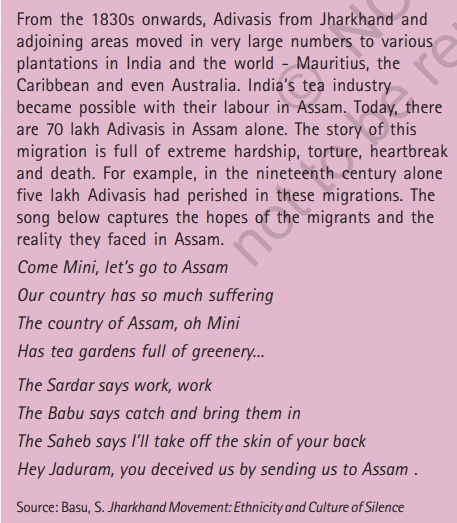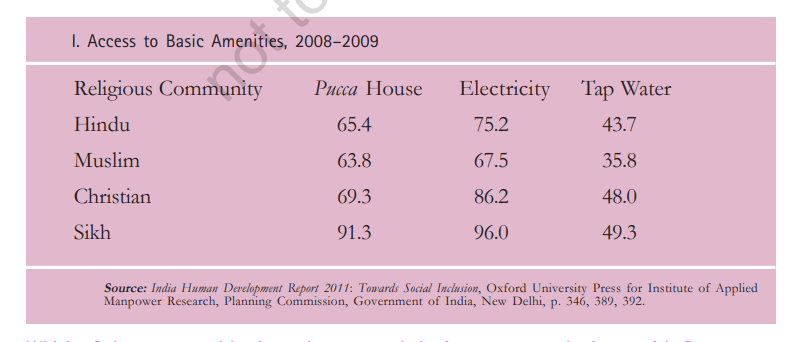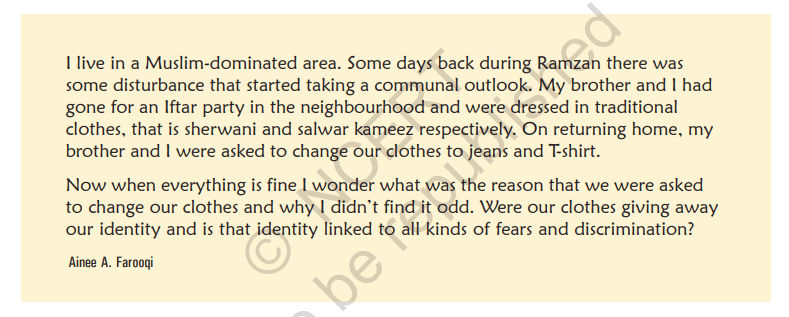Civics - Class 8
Social and Political Life - III
Chapter 7: Understanding Marginalisation
Intext Questions:
Question 1: Explain at least three different reasons why groups may be marginalized?
Answer :Marginalization is the social process of being confined to a lower social standing. Marginalization involves people being denied their fundamental rights which results in lowering their economic and social status.
Marginalisation of any group or a person can be because of many reasons like :
- Speaking a different language,
- Following different customs,
- Belonging to different religious group from the majority community etc.
Question 2: Why was Dadu forced to leave his village in Orissa?
Answer :Dadu was forced to leave his village in Orissa because he was told by forest officials and contractors that the forest was not theirs. These officials and contractors cut down a large part of it.
Then they beat and threatened Dadu till eventually he was forced to sell and abandon the land of his forefathers. They had the support of the authorities.
Question 3: In your own city or village, who would you think are the marginalized groups? Discuss.
Answer :
I am living in a village. I was told that S.C. and S.T. people of my village are Marginalized groups. But later due to economic reasons many people irrespective of caste came under this categarization.
Question 4:
i)Can you name some Adivasi communities that live in your state?
ii)What languages do they speak?
iii)Do they live close to the forest?
iv)Do they migrate to other regions looking for work?
Answer :
i) My state is Andhra Pradesh. Twelve tribes namely Bodo Gadaba, Gutob Gadaba, Bondo Poraja, Khond Poroja, Parangiperja, Chenchu, Dongaria Khonds, Kuttiya Kondhs, Kolam, Kondareddis, Konda Savaras, and Thoti have been recognized as Primitive Tribal Groups (PTGs) of Andhra pradesh.
ii) Gondu, Kolami, Koya, Kuvi, Kui, Yerukala, Savara, Parji, Kupia, Konda and Adivasi Odiya languages
iii) Yes, they live closely to the forest because their livelihood depends upon the forest.
iv)Adivasis do migrate to other regions looking for work.
Question 5: What metals are important in present-day India? Why? Where do they come from? Are there Adivasi populations there?
Answer :Metals important in present-day India are – Iron, manganese, aluminium, copper, gold, silver, etc.
These are important for the development of our country. Iron is used to make machines, agricultural instruments, automobiles, etc. Copper is used to making electrical wires. Aluminium is used to make aeroplanes. Gold and silver are used to make ornaments.
Metals are found beneath the earth which is extracted through mining. They are concentrated mainly in the states of Orissa, Jharkhand, Chhattisgarh, Andhra Pradesh, Madhya Pradesh, Assam, etc.
Yes, the Adivasi populations reside in the above-mentioned states.
Question 6: List five products that you use at home that come from the forest.
Answer :
- Table
- Chair
- Paper
- Construction of houses
- Pencil
Question 7: By whom were the following demands being made on forest land?
- Timber for construction of houses and railways
- Forest land for mining
- Forest land for agriculture by non-tribal people
- Reserved by the government as wildlife parks
Answer :
The demand mentioned in the question above is made by the state (political force) and private industry.
Question 8: In what ways would this affect tribal people?
Answer :
- Tribal people lose their main source of livelihood and food.
- Due to the loss of their traditional homelands, Adivasis migrate to cities in search of work where they are employed for very low wages in local industries and in building construction work.
- Apart from their land, they lose their traditions and customs a way of living.
Question 9: What do you think this poem is trying to convey?

Answer :
This poem is trying to convey when Adivasis were forced to leave their land they lost their sources of livelihood and went through various hardships. They had no means of livelihood anymore. Finally, they decided to go to Assam in search of a job as they heard from someone that there are huge tea gardens.
When they reach Assam all their dreams shattered since there they experienced more hardships. The supervisors order them (labourers) to do more and more work. Labourers are often beaten by their masters. If any labour tries to run away, the master (Babu) sent four-person behind him.
The Adivasis (labourers) experienced much worst life as they are tortured by the Babus on a tea plantation. Adivasis regret their decision of coming to Assam. In conclusion, the life of Adivasis did not improve but degraded day by day No hopes left for them.
Question 10: In your opinion, why is it important that Adivasis should have a sky in how their forests and forest lands are used?
Answer :
Adivasis live in close association with forests. They have a deep knowledge of and access to most of the vast tracts of forests and forest resources. Adivasis also suggest certain ways or measures through which they can continue to live in their land and the government or private industries can also practice mining, agriculture, construction, etc.
Adivasis can also provide us information about the valuable medicinal herbs and other products found in the forests. Therefore, Adivasis should have a say in how their forests and forest lands are used.
Question 11: Why do we need safeguards for minorities?
Answer :Safeguards are needed for minorities:
- To protect minority communities against the possibility of being culturally dominated by the majority.
- To protect them against any discrimination and disadvantage they may face.
- To protect India’s cultural diversity and promoting equality as well as justice.
Question 12: Which of these communities have the most and the least access to basic amenities?

Answer :
Sikhs have the most access to the basic amenities while Muslims have the least access to the basic amenities.
Question 13:Which of these communities have the highest and the lowest literacy rate?

Answer :
Jains have the highest literacy rate (86%) while Muslims have the lowest literacy rate (57%).
Question 14:What do these figures convey?

Answer :
In comparison to the total population of Muslims in India, the percentage of public employment is quite less. In-State PSU the representation of the Muslim community is better. But their percentage in IAS, IPS, IFS, Central Public Sector Unit (PSU), Bank, and RBI is less.
Question 15: Read the data related to schooling provided by the Sachar Committee Report:
25 percent of Muslim children in the 6-14 years age group have either never been, enrolled in school or have dropped out. This percentage is much higher than that of any other socio-religious community (Page No. 58).
Question : Do you think special measures are required to address this situation?
Answer :
Yes, special measures are required to address this situation. Awareness has to be made in the Muslim community regarding literacy. They should be encouraged to send their children to schools.
Question 16: The given essay has been written by a child around your age. What do you think she is trying to convey?

Answer :
She is trying to convey that in our society discrimination prevails between different religious groups or communities, which often converts into communal riots. It leads to bloodshed, loss of life and property. It also generates fear and hatred between different religious groups. Due to fear of death or losing dear ones, people try to hide their identity from other religious groups.
Exercises
Question 1: Write in your own words two or more sentences of what you understand by the word 'marginalisation'.
Answer :The word ‘marginalisation’ simply means exclusion from the mainstream.
Marginalisation of any community or a person can be because of many reasons like
- Speaking a different language,
- Following different customs,
- Belonging to different religious group from the majority community etc.
Marginalisation is linked to experiencing disadvantage, prejudice, poverty and powerlessness. It is a complex phenomenon which results into a low social status, not having equal access to education and other resources.
Question 2: List two reasons why Adivasis are becoming increasingly marginalized.
Answer :The two reasons why Adivasis are becoming increasingly marginalised are:
- The people often wrongly believe that Adivasis are exotic, primitive and backward.
- That often Adivasis are blamed for their lack of advancement as they are believed to be resistant to change or new ideas.
Question 3: Write one reason why you think the constitution's safeguards to protect minority communities are very important?
Answer :The Constitution's safeguards to protect minority communities are very important because they ensure that India's cultural diversity is protected from becoming largely unitary and they also help to promote equality and justice to all.
Question 4:Re-read the section on Minorities and marginalization. What do you understand by the term minority?
Answer :Minority is the term which means the communities which are small in number in comparison to the communities which are more in number.
For example, Muslims are in minority in comparison to Hindus.
Question 5: You are participating in a debate where you have to provide reasons to support the following statement: 'Muslims are a marginalized community'. Using the data provided in this chapter, list two reasons that you would give.
Answer :Two reasons in support of the statement "Muslims are a marginalized community":
- The Muslim community has not been able to gain from the country's socioeconomic development as statistics on basic amenities, literacy rate and public employment show. 63.6% Muslims live in kutcha houses as compared to only 55.2% Hindus also the literacy rate amongst Muslims was the lowest at 59% in a 2001 survey.
- Their customs are distinct from other religious communities, so much so that they are identified as separate from the "rest of us" leading to unfair treatment and discrimination against Muslims.
Question 6: Imagine that you are watching the Republic Day parade on TV with a friend and she remarks, "Look at these tribals. They look so exotic. And they seem to be dancing all the time". List three things that you would tell her about the lives of Adivasis in India.
Answer :
The three things I would tell a friend about the Adivasis in India would be:
- Lives of Adivasis are actually very rich but people seem to know very little about the realities of their lives.
- They are usually shown in sympathetically in colourful costumes, headgear and dancing.
- Often people wrongly believe that Ad are exotic, primitive, backward and immune to development.
Question 7: In the storyboard, you read about how Helen hopes to make a movie on the Adivasi story. Can you help her by developing a short story on Adivasis?
Answer :
Adivasis are a primitive community living in and/or near forests:
- Around 8% of India’s population is of Adivasis. Most important mining and industrial centers like Bokaro, Rourkela, Jameshdpur are located in their area.
- They are not homogeneous populations: There are about 500 different Adivasi groups in India.
- They are in large numbers in the states like Andhra Pradesh, Jharkhand, Odisha, North Eastern States.
- Odisha is home for at least 60 different tribal groups.
- Other states where Adivasis live in sufficient numbers are:
- Chattisgarh, Madhya Pradesh, Gujarat, Maharashtra, and Rajasthan.
- They do not have a hierarchical social structure like other communities.
- They are radically different from other Indian societies in which the caste system is there.
Question 8: Would you agree with the statement that economic marginalisation and social marginalisation are interlinked? Why?
Answer :
Yes, economic and social marginalisations are interlinked. This can be described by the following:
- The minorities are rendered marginalised economically because they are not allowed access to the benefits of economic development.
- When there is no economic development the minorities do not develop socially. Their society does no experience the fruits of social development. They remain backward.